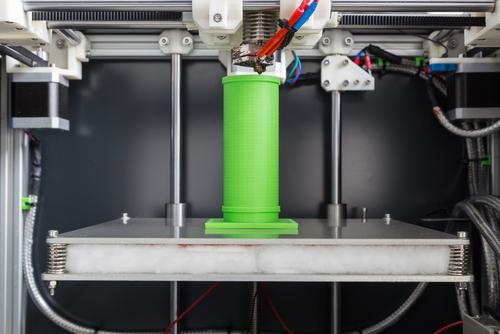3D Printing: The Next 5 years
Mar 31, 2015
The 3D printing field is expected to grow more than 14% annually to become an $8.4 billion industry by 2020, according to a 2013 report by MarketsandMarkets. Currently, North America and Asia-Pacific are the two largest 3D printing markets. Europe is following close behind and expected to overtake North America by 2020. 3D printing, also known as additive manufacturing, is poised to reinvent the way our culture brings an idea to life, shifting how we think about ideation and production. Let’s take a look at 3D printing and how additive manufacturing will revolutionize the technological futures of countless industries.
Disruptive Technologies
You can’t explore the use of 3D printing throughout industries without addressing disruptive innovation, the process of replacing old technologies by completely eradicating or coexisting with what existed before. Disruptive technology is defined as technology designed to create a new market by generating a unique set of standards that eventually overtake the existing market. 3D  printing joins a list of disruptive technologies that includes smartphones, the Internet, cloud technology, and laparoscopic surgery.
printing joins a list of disruptive technologies that includes smartphones, the Internet, cloud technology, and laparoscopic surgery.
For example, when Ford introduced the mass-produced automobile, it changed the horse and buggy culture of the Western world. Subsequently, electric cars are changing the future of today’s gasoline cars. The outcome influences the current market, but it’s the change in the ideation process that creates revolutionary effects.
User Convenience
“3D printing empowers the user — not just the business owner and investor,” according to Apple Rubber, a leading designer and manufacturer of rubber compounds and sealing technology. Apple Rubber’s manufacturing process doesn’t quite align with 3D printing just yet, due to price and the need to produce custom parts for specific applications. But as a proponent of 3D printing, the company is keeping a close eye on how evolving 3D technologies can enhance Apple Rubber’s future and advocates its benefits.
“Inventors now have everything they need,” informs Andrew Rich, an Apple Rubber project engineer. “People can now design on their own home computer and print it out—not pay thousands of dollars to have larger companies make prototypes. Manufacturers may end up touching it in the production phase, but not early on. 3D printing is bringing innovation to the general public.”
3D printing provides equal opportunities and even consumer convenience. The technology enables consumers to go online where they can find prototypes and print the schematics right from their home. Being able to create your idea in the comfort of your home is shifting the creative assets of the world away from singular companies.
The New DIY
Since 3D printing allows prototyping to be accessible to individuals, it takes the first steps to democratize manufacturing. We can shift away from big business manufacturing to economical do-it-yourself production. For example, instead of a big biomedical firm investing millions into development, doctors at St. Luke’s and Roosevelt Hospitals in Manhattan were able to 3D print a trachea for implantation at a fraction of the cost, the Daily News reported. Using stem cells and 3D printing technology, Dr. Faiz Bhora created bioengineered tracheas. Dr. Faiz Bho ra and his team printed a 3D silicone model of the trachea created from biologic material and based on CAT scan data, using a Fab@Home 3D printer (in only 15 minutes). The vision is to implant these 3D trachea models in human patients within a few years.
ra and his team printed a 3D silicone model of the trachea created from biologic material and based on CAT scan data, using a Fab@Home 3D printer (in only 15 minutes). The vision is to implant these 3D trachea models in human patients within a few years.
Even jewelers like David Wilkinson use 3D printing to render models of design concepts. The jewelry designer created a one-of-a-kind custom Legend of Zelda engagement ring. The engagement ring was initially designed in Wings3D to replicate hero Link’s iconic weapon. Wilkinson refined the design and used a Minitech milling machine to give it a detailed 3D render. The band was cast in 14K white gold and the three-pronged Triforce head was made with 14K yellow gold. White stone diamond baguettes sparkle in each link along the band, and the lab-grown yellow sapphire stands out as the ring’s focal point.
Mainstream Resistance
The adoption of additive manufacturing is increasing dramatically, but there is still an overall resistance to its place in mainstream companies. Estimates vary, but all show that less than 10% of companies use additive manufacturing technologies, according to the report “Fostering Mainstream Adoption of Industrial 3D Printing.” Much of this has to do with the effect it will have on the process of idea generation and fulfillment. Using a 3D printer, a developer can go directly from idea to functional prototype without the need for a mockup team, parts runners, or interim managerial approval. It diminishes the strength of large companies and uses staff-intensive supportive departments. It places feet under smaller businesses embracing rapid innovation.
The Internet of Things
Our new digital world links human behavior to the devices we use every day. A smartphone can control our TV watching, the environment of our homes, and how often we work out. This Internet of Things is predicted to have 26 billion devices attached to it by the year 2020. Additive manufacturing is the development arm of the IoT — an interconnection of computing devices inside the framework of the Internet. IoT aims to enable automation through advanced connectivity of devices, systems, and services, from human heart monitor plants to field operation tools, explains 3DPrint.com.
of Things is predicted to have 26 billion devices attached to it by the year 2020. Additive manufacturing is the development arm of the IoT — an interconnection of computing devices inside the framework of the Internet. IoT aims to enable automation through advanced connectivity of devices, systems, and services, from human heart monitor plants to field operation tools, explains 3DPrint.com.
In our “How Nano 3D Electronics Printing Will Drive the Internet of Things,” TE Edwards delves into how plastic printed electronics produced by 3D printing technologies are critical to developing IoT advancements. Within 10 years, plastic circuits could operate at the same performance levels of today’s silicon circuits. Also, plastic printed transistors will be essential for creating wearable electronics and other IoT innovations.
Terminator-Inspired 3D Printing: From Liquid to Object
 Recently, developments in 3D printing have even innovated continuous liquid interface production. Materializing objects out of a pool of liquid can increase the production speed to up to 100 times faster than conventional 3D printing, according to the startup Carbon3D. The CLIP (Continuous Liquid Interface Production) technique uses photochemistry. Designs come from liquid resin, and the media is solidified into the object using light and water, according to IFLScience.com.
Recently, developments in 3D printing have even innovated continuous liquid interface production. Materializing objects out of a pool of liquid can increase the production speed to up to 100 times faster than conventional 3D printing, according to the startup Carbon3D. The CLIP (Continuous Liquid Interface Production) technique uses photochemistry. Designs come from liquid resin, and the media is solidified into the object using light and water, according to IFLScience.com.
CLIP produces complex objects that can have microscopic features and incredible geometries crafted at radically fast speeds. “Growing” objects out of a pool of liquid opens a world of opportunity. In medicine, for example, this type of 3D production could even produce custom stents to treat weakened arteries.
Speed, opportunity for innovations, and the ability to design remotely position additive manufacturing as the most game-changing disruptive technology of our future.
SOURCE: 3DPrint.Com